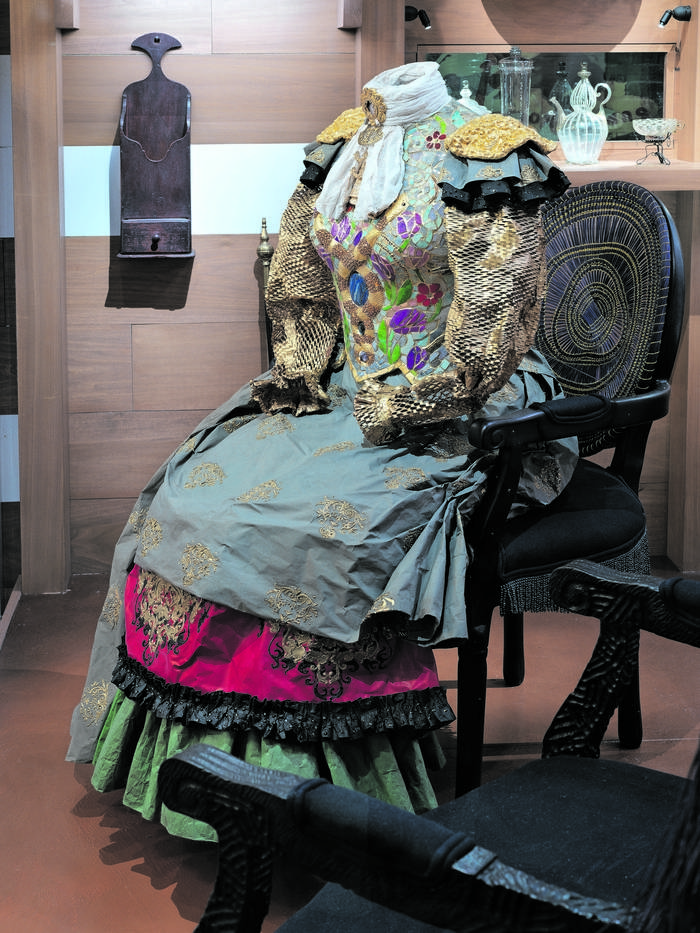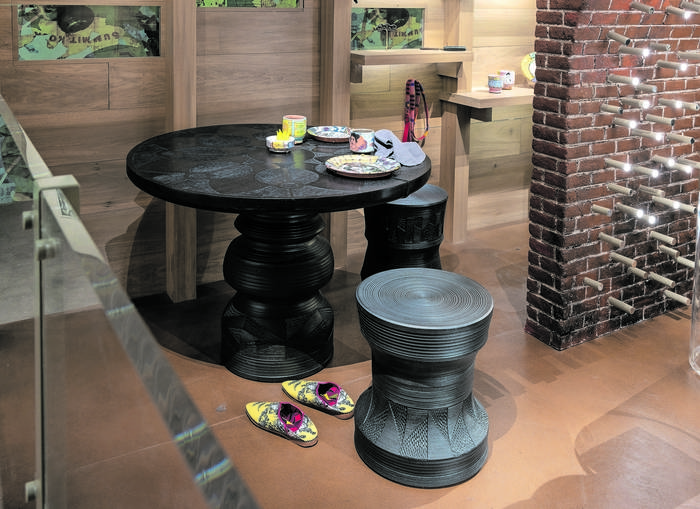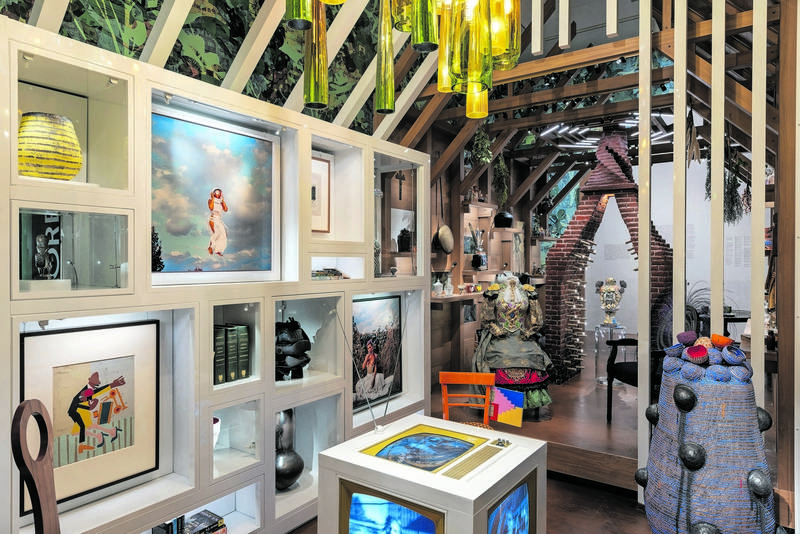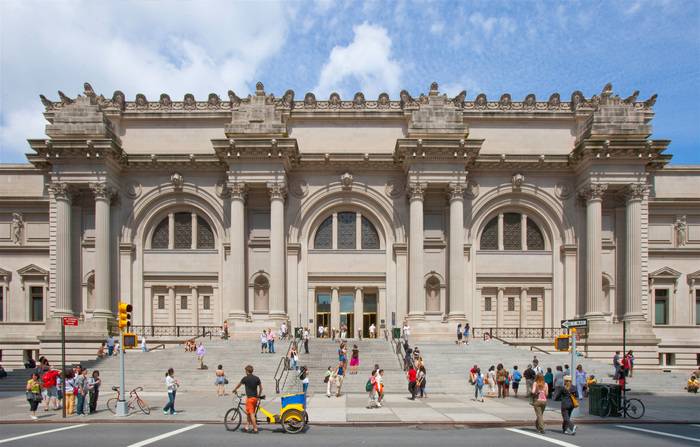Weighing in: Max Hollein, director of the Metropolitan Museum of Art in New York, visited South Africa recently. Photo: Lelanie Foster
On a Sunday in March, Max Hollein, the director of the Metropolitan Museum of Art in New York, ended his day-long blitz of various Cape Town museums by visiting the Denis Goldberg House of Hope in Hout Bay.
It was an auspicious moment for this modest community arts centre opened just two years ago, but equally consequential for the wider arts and culture sector of the continent.
Hollein is the first director in the Met’s 154-year history to make an official visit to Africa.
Tall and smartly dressed in a business suit, Vienna-born Hollein listened as former judge Albie Sachs recalled the life of the avuncular political activist for whom the arts centre is named.
When Hollein was invited to say a few words, he complimented artist Ralph Borland for his presentation exploring the overlaps and affinities between art, design and science.
“We live in a world that is a better world because of art and artists,” remarked Hollein, who heads up the fourth-largest museum in the world and the largest in the Americas.
But Hollein wasn’t in Hout Bay to dish out impromptu plaudits to local artists. His visit to Cape Town marked the start of a two-week business trip to museums and cultural sites across southern and East Africa.
 The show Before Yesterday We Could Fly celebrates African acquisitions by artists such as Atang Tshikare.
The show Before Yesterday We Could Fly celebrates African acquisitions by artists such as Atang Tshikare.
Accompanied by Alisa LaGamma, the Met’s curator of African art, his itinerary included guided museum visits in Cape Town and Johannesburg, as well as tours of Great Zimbabwe and the ruins of Kilwa Kisiwani, off the coast of southern Tanzania.
The diverse itinerary is indicative of the Met’s broad remit as an encyclopaedic museum. It collects everything from armour and fashion to photography and musical instruments. It even buys and accepts gifts of paintings, that trophy of the merchant class.
“The Met is, yes, a big universal institution,” Hollein began his speech in Hout Bay. “We have over 1.5 million objects in our care.”
These objects represent various cultures and epochs, including the arts of Africa.
The Met holds about 26 000 pieces of Egyptian art dating from the Palaeolithic to the Roman period. The Michael C Rockefeller Wing — opened in 1982 and named for a scion of the Rockefeller dynasty who died while on a collecting expedition in New Guinea in 1961 — is home to nearly 3 000 works from sub-Saharan Africa produced over the past 800 years.
While there is a bias towards Central and West Africa in the Rockefeller Wing’s holdings, South African creativity features strongly in the Met’s overall collection.
In 2013, it jointly acquired William Kentridge’s technically audacious five-channel video installation The Refusal of Time (2012) with the San Francisco Museum of Modern Art.
It holds important photographs by Ernest Cole and David Goldblatt, a remarkable collapsed ceramic vessel by Andile Dyalvane and an elegant silk dress with a figural motif by Thebe Magugu.
Other local artists and designers with works in the museum’s collection include Nicholas Hlobo, Pieter Hugo, Chuma Maweni, Zizipho Poswa and Atang Tshikare. This list is likely to grow in the years to come.
“When we re-open the Rockefeller Wing next year and our new wing of modern, contemporary art,” Hollein told his Hout Bay audience, “art from South Africa will play an important role. That means continuous dialogues and collaborations.”
Earlier in the day, I met Hollein and LaGamma at The South African Museum to talk about their visit in greater detail.
“This is not a social trip,” insisted Hollein. “I purposefully didn’t come for the art fair.”
There is a lot of work to be done.
 The show Before Yesterday We Could Fly celebrates African acquisitions by artists such as Chuma Maweni
The show Before Yesterday We Could Fly celebrates African acquisitions by artists such as Chuma Maweni
The Met is committed to spending $1.5 to $2 billion in the next eight years only renewing, not extending, its galleries. Early next year, when the Rockefeller Wing re-opens, it will showcase its three distinct collections of African art, ancient American art and Oceanic art in bold new ways.
Over the past 18 months, the Met has been producing digital and in-gallery video content at significant cultural heritage sites, including Lalibela and Tigray in Ethiopia and the Wamala and Kasubi tombs in Uganda.
The intention is to present this documentary content, filmed by Ethiopian-American filmmaker Sosena Solomon, in the museum’s African art galleries.
“The galleries are, of course, centred around objects and the artistic context of that,” said Hollein. “But we want to position the objects in a broader framework.”
This dynamic way of showcasing classical African art is not entirely new for the museum and predates Hollein’s appointment in 2018.
In 2015, the Met opened Kongo: Power and Majesty, an impressive exhibition of wood and brass sculptures and textiles produced by artists in present-day Angola between the 16th and 19th centuries. It included an immersive video installation.
Cape Town photographer Jo Ractliffe was also invited to show 23 photos of desert scenes where conflict had occurred during the South African Border War.
The New York Times described it as an “idea-filled and troubling show”. Troubling how? Earlier in 2015, before Kongo opened, the controversial Congolese businessman and art collector Sindika Dokolo added his voice to a growing chorus calling for Western museums to return looted artefacts.
 The show Before Yesterday We Could Fly celebrates African acquisitions by artists such as Zizipho Poswa.
The show Before Yesterday We Could Fly celebrates African acquisitions by artists such as Zizipho Poswa.
“There are works that disappeared from Africa and are now circulating on the world market based on obvious lies about how they got there,” said Dokolo.
Some of them ended up in the Met. In 2021, the museum restored three works looted from the Nigerian royal palace in 1897 to the Nigerian National Commission for Museums and Monuments.
Hollein’s tenure as director coincides with a sea change in attitudes towards the cultural patrimony of Africa held in Western museums.
In 2018, a report commissioned by French President Emmanuel Macron laid out the intellectual foundations and practical steps for the repatriation of cultural artefacts from Africa.
Authored by Senegalese economist Felwine Sarr and French art historian Bénédicte Savoy, the report looked specifically at France’s wrongdoings and extensive holdings of about 90 000 objects from sub-Saharan Africa. It motivated for the immediate restitution of two dozen symbolic artefacts from Benin, Ethiopia, Mali, Nigeria and Senegal.
“This is a big topic and has a whole number of layers,” responded Hollein, when I raised Dokolo’s criticisms and the Sarr-Savoy Report.
One layer, he said, involves the political environment in the US, which is essentially laissez-faire, leaving it to museums to regulate policy. Hollein reiterated his museum’s initiatives in reimagining the Rockefeller Wing and plans to integrate African art into the forthcoming modern and contemporary wing.
 The Metropolitan Museum of Art in New York
The Metropolitan Museum of Art in New York
He also emphasised the dynamic Africa-led programming introduced during the current pause.
Launched last year, the Africa in Focus programme has involved various exhibitions, partnerships and programmes.
South African dancer and choreographer Nelisiwe Xaba was invited to spend a month at the museum researching a major new work.
Kenyan-American artist Wangechi Mutu showed sentinel-like figures on the exterior façade, the first time an artist has ever been invited to do so.
The museum is preparing an exhibition for Senegalese modernist artist Iba Ndiaye.
“We want to make sure that people appreciate the strong history of modernism in African art,” said Hollein. “You hear a lot about cutting-edge contemporary artists, but we want to make sure that that foundational aspect is known and understood.
“We will continue to do that, in a more systemic way, and that is part of the trip.
“Our interest is genuine, our approach is profound and the commitment is exactly that,” insisted Hollein.
“The Met is a very good place for objects, not only because we conserve and take care of them, but the level of research and sharing of information is really significant.
“We are trying to create an environment where visitors can see them in a perfect setting. Our investment into that is major and continuous.”
As anyone familiar with the Johannesburg Art Gallery’s shambolic decline will know, the care of objects is a labour unto itself.
In 2021, the Met signed a formal agreement with the Nigerian National Commission for Museums and Monuments. It is also developing a documentation and education initiative with the National Museum in Lagos.
“We asked our colleagues in Lagos what they needed most,” said Hollein. “The number one thing was to help them facilitate and understand how best to digitise their collection.”
“They only have the paper ledgers from the 1950s,” expanded LaGamma.
“They have phenomenal collections, but they are not really accessible, because there is an anxiety around security issues.”
Visibility is something New York museums excel at. What might greater visibility of African patrimony located on the continent, even if digital, do for its citizens? Could it engender pride?
Yes, agreed Hollein, but it would also raise awareness, knowledge and probably create a context for how these objects came into the world, how they relate to others, and what their influence and impact is.
Given the global drift into digital distraction, I asked Hollein if seriousness, which his museum undeniably champions, is under threat?
“No,” he replied.
“Our audience numbers keep increasing. The on-site visiting experience is very different to anything you experience digitally. It is also important to note that the average stay at the Met has not changed over the last decade.”
This prompted a related question: Is seriousness worth defending? Hollein, the worldly defender of artists and champion of cosmopolitanism, briefly stumbled.
“Whatever we do, we do seriously and with a major commitment,” he corrected himself. “It doesn’t mean we do it in a way that is one-dimensional, only telling you one story. You see a lot of programmes and exhibitions that raise more questions than offer answers.
“Sometimes it is more interesting for an audience to hear from us what we don’t know than what we know. What we don’t know is sometimes very revelatory about why there is a knowledge gap.”